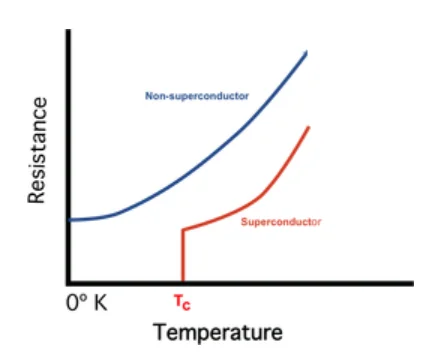Superconductivity is a remarkable phenomenon where certain materials can conduct electricity without any resistance and expel magnetic fields when cooled below a critical temperature. Discovered over a century ago, this property has led to significant technological advancements. Despite our understanding of some aspects of superconductivity, the discovery of new high-temperature superconductors continues to challenge and expand our knowledge.
An Overview of Superconductor
Understanding Electrical Resistance and Superconductors
- Electrical Resistance: At normal temperatures, all materials resist the flow of electricity, like a narrow pipe resists water flow.
- This resistance causes energy loss as heat in devices like computers and cell phones.
- Most materials keep this resistance even at very low temperatures.
- Superconductors: However, superconductors are special materials that, when cooled below a critical temperature (Tc), can conduct electricity without any energy loss.
- They also expel magnetic fields in this state.
Discovery and Explanation
- Superconductivity was discovered over 100 years ago in mercury cooled to liquid helium temperatures (-452°F).
- In 1957, three physicists used quantum mechanics to explain that below Tc, electrons form pairs held together by vibrations called phonons.
- These pairs move through the material without resistance.
Key Superconductivity Facts
- 1911: Superconductivity was discovered by Heike Kamerlingh-Onnes, who won the 1913 Nobel Prize in Physics.
- Nobel Prizes: Five Nobel Prizes were awarded for superconductivity research (1913, 1972, 1973, 1987, 2003).
- Low-Temperature Superconductors: About half the elements can become superconductors at low temperatures, but alloys like niobium-titanium are often used for practical applications, such as in MRI machines.
|
Key Aspects of Superconductivity Technology
- Superconductivity is a phenomenon observed in certain materials where they can conduct electricity with zero electrical resistance and expel magnetic fields. Here are key aspects of superconductivity technology:
- Zero Electrical Resistance: The most distinguishing feature of superconductors is their ability to conduct electricity without any resistance.
- This means that once a current is established in a superconducting loop, it can persist indefinitely without any loss of energy.
- Critical Temperature (Tc): Superconductivity is typically observed below a critical temperature unique to each material.
- Above this critical temperature, the material behaves like a normal conductor, but below it, the superconducting state emerges.
Types of Superconductors

- Type I Superconductors: Exhibit a sharp transition to the superconducting state at a specific critical temperature.
- Examples: include lead and mercury.
- Type II Superconductors: Have a more gradual transition and can exist in a mixed state where some parts are superconducting and others are not.
- Examples: include niobium-titanium and yttrium-barium-copper oxide.
Applications
- Magnetic Levitation: Superconductors expel magnetic fields, leading to applications like magnetic levitation (Maglev) trains.
- The lack of resistance allows Maglev trains to travel at high speeds with minimal energy loss.
- MRI (Magnetic Resonance Imaging): Superconducting magnets are used in medical imaging devices like MRI machines, providing strong and stable magnetic fields for detailed imaging.
- Electric Power Transmission: Superconductors can be used in power cables to transmit electricity with minimal loss, increasing the efficiency of power distribution.
- Quantum Computing: Superconducting materials are being explored for use in quantum computers, where the qubits can be implemented as superconducting circuits.
High-Temperature Superconductors (HTS)
- Early superconductors required extremely low temperatures (near absolute zero), but HTS materials can exhibit superconductivity at higher temperatures, although still below room temperature.
- In 1986, scientists found copper-oxide materials that became superconductors at much higher temperatures than previous materials, some above liquid nitrogen temperatures (-321°F).
- This discovery hinted at new technological possibilities and suggested that even higher-temperature superconductors might be found.
- Yttrium-barium-copper oxide (YBCO) is an example of a high-temperature superconductor.
Challenges and Limitations
- Cooling Requirements: Many superconductors require extremely low temperatures to maintain their superconducting state, which can be a technological challenge.
- Material Cost: Some superconducting materials, especially high-temperature superconductors, can be expensive.
- Current Limitations: Practical applications are often limited by the current-carrying capacity and stability of superconductors.
Ongoing Research and Development
- Ongoing research aims to discover new superconducting materials with higher critical temperatures and better properties for various applications.
- Since then, many new high-temperature superconductors have been discovered through experiments and educated guesses, including iron-based materials.
- However, the existing theory for metal superconductors doesn’t explain these new materials, presenting a fresh challenge to scientists.
- Scientists are exploring ways to overcome existing challenges and make superconductivity more practical for widespread use.
Conclusion
- Superconductivity holds immense potential for various applications, from powerful magnets in MRI machines to efficient power transmission and quantum computing.
- While challenges such as cooling requirements and material costs persist, ongoing research aims to find new materials with higher critical temperatures and improved properties.
- The future of superconductivity promises revolutionary advancements in technology and science.
![]() June 11, 2024
June 11, 2024
![]() 961
961
![]() 0
0
